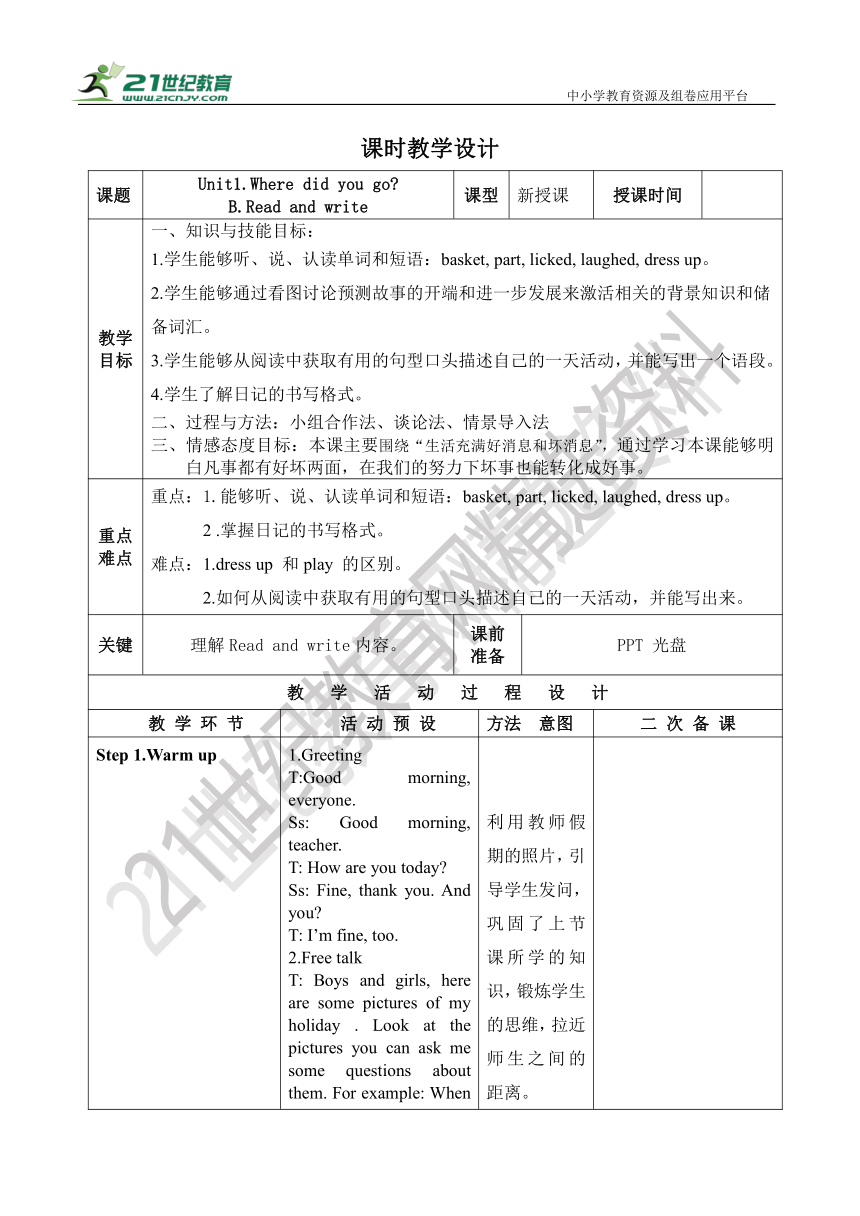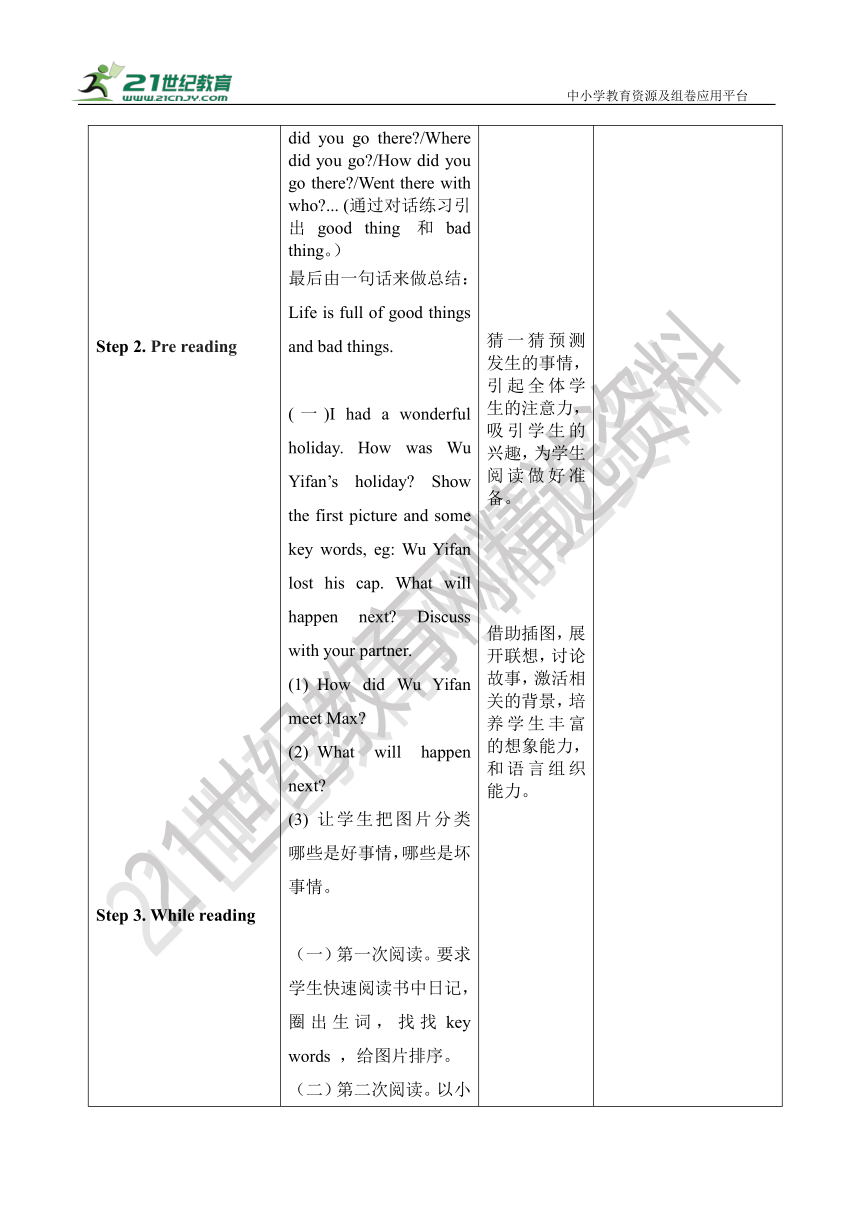【课堂跟踪】Unit 3 Where did you go B Read and write 教案
文档属性
| 名称 | 【课堂跟踪】Unit 3 Where did you go B Read and write 教案 |  | |
| 格式 | docx | ||
| 文件大小 | 131.1KB | ||
| 资源类型 | 试卷 | ||
| 版本资源 | 人教版(PEP) | ||
| 科目 | 英语 | ||
| 更新时间 | 2021-01-15 11:07:57 | ||
图片预览


文档简介
课时教学设计
课题
Unit1.Where did you go?
B.Read and write
课型
新授课
授课时间
教学
目标
一、知识与技能目标:
1.学生能够听、说、认读单词和短语:basket, part, licked, laughed, dress up。
2.学生能够通过看图讨论预测故事的开端和进一步发展来激活相关的背景知识和储备词汇。
3.学生能够从阅读中获取有用的句型口头描述自己的一天活动,并能写出一个语段。
4.学生了解日记的书写格式。
二、过程与方法:小组合作法、谈论法、情景导入法
三、情感态度目标:本课主要围绕“生活充满好消息和坏消息”,通过学习本课能够明白凡事都有好坏两面,在我们的努力下坏事也能转化成好事。
重点难点
重点:1.能够听、说、认读单词和短语:basket, part, licked, laughed, dress up。
2 .掌握日记的书写格式。
难点:1.dress up 和play 的区别。
2.如何从阅读中获取有用的句型口头描述自己的一天活动,并能写出来。
关键
理解Read and write内容。
课前
准备
PPT 光盘
教 学 活 动 过 程 设 计
教 学 环 节
活 动 预 设
方法 意图
二 次 备 课
Step 1.Warm up
Step 2. Pre reading
Step 3. While reading
Step 4. Post reading
1.Greeting
T:Good morning, everyone.
Ss: Good morning, teacher.
T: How are you today?
Ss: Fine, thank you. And you?
T: I’m fine, too.
2.Free talk
T: Boys and girls, here are some pictures of my holiday . Look at the pictures you can ask me some questions about them. For example: When did you go there?/Where did you go?/How did you go there?/Went there with who?... (通过对话练习引出good thing 和bad thing。)
最后由一句话来做总结:Life is full of good things and bad things.
(一)I had a wonderful holiday. How was Wu Yifan’s holiday? Show the first picture and some key words, eg: Wu Yifan lost his cap. What will happen next? Discuss with your partner.
How did Wu Yifan meet Max?
What will happen next?
让学生把图片分类哪些是好事情,哪些是坏事情。
(一)第一次阅读。要求学生快速阅读书中日记,圈出生词,找找key words ,给图片排序。
(二)第二次阅读。以小组合作的方式进行讨论,概括一下这一天发生在吴一凡一家的好事和坏事,填在表格里(书中29页)。
(三)第三次阅读。答问题再次阅读课文:
(1)What was the date?
(2)Where didi Max sit?
(3)Why did they stay in the hotel in the afternoon?
(四)第四次阅读。播放录音,让学生跟读。(提醒学生模仿录音,注意语音语调连续和停顿)
(五)第五次阅读。根据板书关键词Retell the passage.
Talk about the story “塞翁失马焉知非福”
A Good Things or Bad Thing
In the old times, there was an old man. His name was Saiweng. He always thought differently from other people. One day, his horse came out and didn’t come back. His neighbours felt sorry for him. However, he said, “Losing a horse is a bad thing, but maybe it will become a good thing.? Several months later, his horse came back with another fine horse. His neighbours felt happy for him, but he said, “ Maybe it will become a bad thing. ”Just as he worried, one day, his son rode the fine horse. He fell off and hurt his leg. His son became a disabled man. His neighbours were sorry for him again, but he didn’t think so: “Maybe it will become a goo thing again.” One year later, there was a war. Many young men became soldiers and died. His son did not have to serve in the army because of his leg. His leg injury saved his life.
Finish the practice on page 29:write about your bad but good day.Then summary.
利用教师假期的照片,引导学生发问,巩固了上节课所学的知识,锻炼学生的思维,拉近师生之间的距离。
猜一猜预测发生的事情,引起全体学生的注意力,吸引学生的兴趣,为学生阅读做好准备。
借助插图,展开联想,讨论故事,激活相关的背景,培养学生丰富的想象能力,和语言组织能力。
文本教学先整体感知, 然后局部处理,理解细节,最后回到整体。培养学生整体感知、捕捉关键信息的能力。
将真实的材料与本课结合起来,优化课堂教学,拓宽学生的知识面,培养学生的思考能力、分析能力和理解能力,能帮助学生积累阅读的经验和语言。
通过练后师生共同整理和归纳,便于学生理解和记忆。
作业
设计
Read the story for 2 times.
Write a diary about your holiday.
板书
设计
Read and write
sit-sat lick-licked laugh-laughed
Max sat in a basket on the front of the bike.
We dressed up and made a funny play.
Robin played the part of a dog.
It was a bad day but also a good day!
教学反思
课题
Unit1.Where did you go?
B.Read and write
课型
新授课
授课时间
教学
目标
一、知识与技能目标:
1.学生能够听、说、认读单词和短语:basket, part, licked, laughed, dress up。
2.学生能够通过看图讨论预测故事的开端和进一步发展来激活相关的背景知识和储备词汇。
3.学生能够从阅读中获取有用的句型口头描述自己的一天活动,并能写出一个语段。
4.学生了解日记的书写格式。
二、过程与方法:小组合作法、谈论法、情景导入法
三、情感态度目标:本课主要围绕“生活充满好消息和坏消息”,通过学习本课能够明白凡事都有好坏两面,在我们的努力下坏事也能转化成好事。
重点难点
重点:1.能够听、说、认读单词和短语:basket, part, licked, laughed, dress up。
2 .掌握日记的书写格式。
难点:1.dress up 和play 的区别。
2.如何从阅读中获取有用的句型口头描述自己的一天活动,并能写出来。
关键
理解Read and write内容。
课前
准备
PPT 光盘
教 学 活 动 过 程 设 计
教 学 环 节
活 动 预 设
方法 意图
二 次 备 课
Step 1.Warm up
Step 2. Pre reading
Step 3. While reading
Step 4. Post reading
1.Greeting
T:Good morning, everyone.
Ss: Good morning, teacher.
T: How are you today?
Ss: Fine, thank you. And you?
T: I’m fine, too.
2.Free talk
T: Boys and girls, here are some pictures of my holiday . Look at the pictures you can ask me some questions about them. For example: When did you go there?/Where did you go?/How did you go there?/Went there with who?... (通过对话练习引出good thing 和bad thing。)
最后由一句话来做总结:Life is full of good things and bad things.
(一)I had a wonderful holiday. How was Wu Yifan’s holiday? Show the first picture and some key words, eg: Wu Yifan lost his cap. What will happen next? Discuss with your partner.
How did Wu Yifan meet Max?
What will happen next?
让学生把图片分类哪些是好事情,哪些是坏事情。
(一)第一次阅读。要求学生快速阅读书中日记,圈出生词,找找key words ,给图片排序。
(二)第二次阅读。以小组合作的方式进行讨论,概括一下这一天发生在吴一凡一家的好事和坏事,填在表格里(书中29页)。
(三)第三次阅读。答问题再次阅读课文:
(1)What was the date?
(2)Where didi Max sit?
(3)Why did they stay in the hotel in the afternoon?
(四)第四次阅读。播放录音,让学生跟读。(提醒学生模仿录音,注意语音语调连续和停顿)
(五)第五次阅读。根据板书关键词Retell the passage.
Talk about the story “塞翁失马焉知非福”
A Good Things or Bad Thing
In the old times, there was an old man. His name was Saiweng. He always thought differently from other people. One day, his horse came out and didn’t come back. His neighbours felt sorry for him. However, he said, “Losing a horse is a bad thing, but maybe it will become a good thing.? Several months later, his horse came back with another fine horse. His neighbours felt happy for him, but he said, “ Maybe it will become a bad thing. ”Just as he worried, one day, his son rode the fine horse. He fell off and hurt his leg. His son became a disabled man. His neighbours were sorry for him again, but he didn’t think so: “Maybe it will become a goo thing again.” One year later, there was a war. Many young men became soldiers and died. His son did not have to serve in the army because of his leg. His leg injury saved his life.
Finish the practice on page 29:write about your bad but good day.Then summary.
利用教师假期的照片,引导学生发问,巩固了上节课所学的知识,锻炼学生的思维,拉近师生之间的距离。
猜一猜预测发生的事情,引起全体学生的注意力,吸引学生的兴趣,为学生阅读做好准备。
借助插图,展开联想,讨论故事,激活相关的背景,培养学生丰富的想象能力,和语言组织能力。
文本教学先整体感知, 然后局部处理,理解细节,最后回到整体。培养学生整体感知、捕捉关键信息的能力。
将真实的材料与本课结合起来,优化课堂教学,拓宽学生的知识面,培养学生的思考能力、分析能力和理解能力,能帮助学生积累阅读的经验和语言。
通过练后师生共同整理和归纳,便于学生理解和记忆。
作业
设计
Read the story for 2 times.
Write a diary about your holiday.
板书
设计
Read and write
sit-sat lick-licked laugh-laughed
Max sat in a basket on the front of the bike.
We dressed up and made a funny play.
Robin played the part of a dog.
It was a bad day but also a good day!
教学反思
